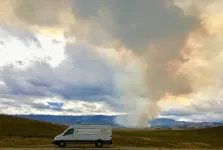(Press-News.org) A study of biomass burning aerosols led by University of Wyoming researchers revealed that smoke from wildfires has more of a cooling effect on the atmosphere than computer models assume.
"The study addresses the impact of wildfires on global climate, and we extensively used the NCAR-Wyoming supercomputer (Cheyenne)," says Shane Murphy, a UW associate professor of atmospheric science. "Also, the paper used observations from UW and other teams around the world to compare to the climate model results. The main conclusion of the work is that wildfire smoke is more cooling than current models assume."
Murphy was a contributing author of a paper, titled "Biomass Burning Aerosols in Most Climate Models Are Too Absorbing," that was published Jan. 12 (today) in Nature Communications, an open-access journal that publishes high-quality research from all areas of the natural sciences. Papers published by the journal represent important advances of significance to specialists within each field.
Hunter Brown, who graduated from UW in fall 2020 with a Ph.D. in atmospheric science, was the paper's lead author. Other contributors to the paper included researchers from Texas A&M University; North Carolina A&T State University; the University of Georgia; the Finnish Meteorological Institute; the Center for International Climate and Environmental Science, and Norwegian Meteorological Institute, both in Oslo, Norway; the University of Reading in the United Kingdom; North-West University in South Africa; the University of Science and Technology of China in Hefei, China; and Pacific Northwest National Laboratory in Richland, Wash.
The composition, size and mixing state of biomass burning aerosols determine the optical properties of smoke plumes in the atmosphere which, in turn, are a major factor in dictating how these aerosols perturb the energy balance in the atmosphere.
"We found that many of the most advanced climate models simulate biomass burning aerosols or smoke that is darker, or more light absorbing, than what we see in observations," says Brown, of Juneau, Alaska. "This has implications for the climate predictions made by these models."
Observations and models used in the study covered a wide temporal range. Africa, South America and Southeastern Asia, in addition to boreal fire regions, were chosen because these are the largest contributors to biomass burning smoke emissions in the world, Brown says.
The National Center for Atmospheric Research (NCAR)-Wyoming Supercomputing Center (NWSC) in Cheyenne was used for all of the data processing and the model sensitivity simulations, Brown says. Some of the other model data used for comparison in this study were generated elsewhere.
"When we compare global observations of wildfire smoke to simulated wildfire smoke from a collection of climate models, the vast majority of the models have smoke that is more light absorbing than the observations," Brown explains. "This means that more energy from the sun is going toward warming the atmosphere in these models, as opposed to what we see in these field campaigns and laboratory studies, which report less absorbing smoke that has more of a cooling effect by scattering light away from the Earth and back to space."
How absorbing these aerosols are in the atmosphere depends on the type of fuel that is burning, as well as the climate of the fire region. Generally, hot, dry grassland fires in Africa and Australia tend to have much darker smoke, which is more absorbing, while cooler, wetter boreal forest fires in North America and Northern Asia tend to have much brighter smoke, which is less absorbing.
After researchers made aerosol improvements to the model, African wildfire smoke still tended to be more absorbing than observations. This might be explained by simplifications in how aerosols evolve over time in the model, or it may be due to a lack of observations from this part of the world biasing the results toward the boreal fire regime, Brown explains.
"We were able to trace the disagreement between the model and observations to how the models represented the individual smoke particles, or aerosols, in the model," Brown says. "This came down to how the model characterized their makeup, their size and the mixtures of different types of biomass burning aerosol. When we changed these variables in one of the models, we saw considerable improvement in the simulated smoke."
This comparison of computer models and global observations is valuable for model development groups and may help reduce uncertainty in biomass burning aerosol climate impacts in models, Brown says.
INFORMATION:
BOSTON - New research from Boston Medical Center finds that using clear, unambiguous language when recommending HPV vaccination both increases vaccine acceptance and increases conversation efficiency while preserving patient satisfaction. Published in Vaccine, the new research findings show that adolescents are nine times more likely to receive a vaccine when providers introduce the topic to parents with a simple statement like "your child is due for vaccines today." It also results in a shorter vaccine discussion.
In this study, the acceptance of the HPV vaccine and the meningococcal vaccine were compared. The indicated ...
A recent statewide survey of Californians uncovered that 30% of Black adults and 13% of Hispanic adults felt that they have been judged or treated differently by a health care provider because of their race/ethnicity or language. One out of six Black and Latino Californians were more likely to report strong mistrust of their health care providers. Researchers at the Charles R. Drew University in Los Angeles analyzed data from more than 2,300 White, Hispanic, and non-Hispanic Black adults who asked to report on perceived discrimination due to race, ethnicity, language, income, and insurance status or type. Black and Hispanic adults reported higher rates ...
Traditional gendered patterns of child care persisted during the COVID-19 shutdown, with more than a third of couples relying on women to provide most or all of it, according to a study from University of Georgia researcher Kristen Shockley.
Some previous research has found that typical familial patterns may get upended during crises, but that's not what Shockley and her colleagues found in the early months of the COVID-19 shutdown.
"Most people have never undergone anything like this before, where all of a sudden they can't rely on their normal child care, and most people's work situation ...
North Carolina did not expand Medicaid eligibility under the Affordable Care Act, which continued to put many low-income women at risk for losing health care coverage post partum. The state did comply with ACA standards for simplifying Medicaid enrollment, automating the process and removing a stringent and often cumbersome financial assessment process. Analysis from researchers at Duke University found that these reforms enabled more low-income women to qualify for full Medicaid and reduced the number of women who instead qualified for more limited benefits under the state's ...
A rapid, evidence-based review summarizes the effectiveness of cloth masks in protecting health care clinicians from respiratory viral infections, such as COVID-19. Nine studies were included in the review, and all but one were conducted prior to the COVID-19 pandemic. The only randomized trial of cloth face masks published at the time of this review compared the infection rates of influenza-like illness among groups of health care professionals who wore cloth masks, medical masks, or inconsistent mask use in the hospital setting. That study reported wide-ranging confidence intervals ...
Despite having some of the densest living spaces and the highest number of international visitors, Hong Kong, Singapore, and Beijing have utilized their respective primary health care systems to keep their COVID-19 cases and deaths relatively low. Researchers studied the primary health care systems in the three cities to identify features of each system that other cities can use as examples to prepare for and prevent deaths in future health crises. Wong et al write that all three cities have made use of primary care in performing public health surveillance and ...
Physical pain and social pain may be more closely related than previously thought. Social pain, which typically results from interpersonal rejection or abuse, has been viewed as a non-medical response to external factors. However, recent research suggests that some physical and social stress responses may arise because of shared processing in the brain. Long-term usage of opioid medications could perpetuate a cycle of experiencing both physical and social pain and may increase risk of addiction. The authors, both of whom prescribe opioid medications, caution, "We must recognize ...
Despite seeing gains in insurance coverage for preventive health services under the Affordable Care Act, the US has seen a declining rate of primary care visits over the past fifteen years. Are fewer individuals seeing primary care physicians? The authors of this study compared two factors that contribute to that decline to determine whether it was the number of primary care patients or the frequency of their clinical visits that contributed most to the overall decline. Over a fifteen year period from 2002 to 2017, both the number of unique patients seeing PCPs and the number of visits per patient declined. At the start of their analysis in 2002, most Americans saw a primary care physician about 4.3 times in a two-year span. By the end of the study in 2016, frequency ...
Patients are sometimes asked to share their personal health information for research purposes. Informed consent and trust are critical components in a patient's decision to participate in research. Researchers at the University of Florida conducted a three-arm randomized controlled trial to compare the effects on patient experiences of three electronic consent (e-consent) designs that asked them to share PHI for research purposes. Participants were randomized to a standard e-consent form (standard); an e-consent that contained standard information plus hyperlinks to additional interactive details (interactive); or an e-consent that contained standard information, interactive hyperlinks, and factual ...
URBANA, Ill. - Soil erosion is a major challenge in agricultural production. It affects soil quality and carries nutrient sediments that pollute waterways. While soil erosion is a naturally occurring process, agricultural activities such as conventional tilling exacerbate it. Farmers implementing no-till practices can significantly reduce soil erosion rates, a new University of Illinois study shows.
Completely shifting to no-till would reduce soil loss and sediment yield by more than 70%, says Sanghyun Lee, doctoral student in the Department of Agricultural and Biological Engineering at U of I and lead author on the study, published in Journal of Environmental Management.
But even a partial change in tilling practices could have significant results, he adds.
"If we ...

